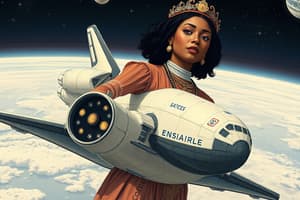Podcast
Questions and Answers
What type of propellants did the External Tank hold for the Main Engines?
What type of propellants did the External Tank hold for the Main Engines?
- Solid fuel segments
- Liquid nitrogen and liquid helium
- Liquid hydrogen and liquid oxygen (correct)
- Hydrogen gas and nitrogen
Which company built the Solid Rocket Boosters for the Space Shuttle?
Which company built the Solid Rocket Boosters for the Space Shuttle?
- Boeing Corporation
- Lockheed Martin
- SpaceX
- Thiokol Corporation (correct)
At what speed did the Space Shuttle reach during launch?
At what speed did the Space Shuttle reach during launch?
- Close to Mach 5
- Close to Mach 10
- Close to Mach 50
- Close to Mach 20 (correct)
How did the Space Shuttle return to Earth after completing its mission in orbit?
How did the Space Shuttle return to Earth after completing its mission in orbit?
Why did the Space Shuttle program come to an end in 2011?
Why did the Space Shuttle program come to an end in 2011?
What is being developed as a successor to the Space Shuttle, according to the text?
What is being developed as a successor to the Space Shuttle, according to the text?
Who initiated the design studies for an orbiting spaceplane in 1972?
Who initiated the design studies for an orbiting spaceplane in 1972?
What concept did the Orbiting Reentry Vehicle evolve into in the early 1970s?
What concept did the Orbiting Reentry Vehicle evolve into in the early 1970s?
What were the three main components of the Space Shuttle?
What were the three main components of the Space Shuttle?
Which company was NOT involved in designing or building components of the Space Shuttle?
Which company was NOT involved in designing or building components of the Space Shuttle?
What accelerated plans for the shuttle development in the 1960s?
What accelerated plans for the shuttle development in the 1960s?
What concept lost out to the Shuttle Concept in 1976?
What concept lost out to the Shuttle Concept in 1976?
Study Notes
SST - A Brief Overview of Space Shuttle Technology
The Space Transportation System (SST) is commonly known as the Space Shuttle, which was a partially reusable orbital spacecraft system operated by NASA from 1981 through 2011. This article provides a brief overview of the history behind this remarkable technology.
Origins and Development
The idea for developing a reusable space vehicle dates back to the late 1950s when Wernher von Braun began studying how rocket engines could be modified to operate like airplane engines. However, it wasn't until President John F. Kennedy's 1961 commitment to sending astronauts to the Moon before the Soviet Union that plans for the shuttle were accelerated.
In 1972, NASA initiated design studies for an orbiting spaceplane called the Orbiting Reentry Vehicle. The following year, this evolved into the Single Stage To Orbit (SSTO) concept, with two versions developed--the VentureStar Single Stage to Orbit (SSTO) and the Hughes VentureStar SSOT. In 1976, these concepts lost out to the Shuttle Concept, which became the final design of the Space Shuttle.
Design and Construction
The Space Shuttle had three main components: the Orbiter, which housed the crew and payload; the External Tank; and the pair of Solid Rocket Boosters. These parts were designed and built by various contractors, including Boeing, Rockwell International, and Lockheed Martin.
External Tanks
The External Tank, made primarily of aluminum alloy, held liquid hydrogen and liquid oxygen propellants for the Main Engines located within the Shuttle's fuselage.
Solid Rocket Boosters
The Solid Rocket Boosters were built by Thiokol Corporation and gave the Space Shuttle its lift off power. Each booster contained six solid fuel segments packed around a hollow steel casing.
Launch and Return
At launch, the Space Shuttle would reach speeds close to Mach 20 before the first stage separated, leaving the External Tank and the Solid Rocket Boosters behind. Once in orbit, the Shuttle would return to Earth and glide back down, landing on the runway like an aircraft.
Retirement and Future Plans
After 135 missions between 1981 and 2011, including deployments of satellites, construction of the International Space Station, and scientific research, the Space Shuttle program came to an end due to budget constraints and limited commercial potential. Now, efforts are being made to develop a successor to the Space Shuttle, such as the proposed Vulcan rocket.
In conclusion, the Space Shuttle represented a significant milestone in space exploration, demonstrating a new level of reusability and versatility that continue to influence modern space travel today.
Studying That Suits You
Use AI to generate personalized quizzes and flashcards to suit your learning preferences.
Description
Test your knowledge about the history, design, construction, and missions of the Space Shuttle, also known as the Space Transportation System (SST), through this informative quiz. Explore the technology behind this iconic spacecraft and its impact on space exploration.



